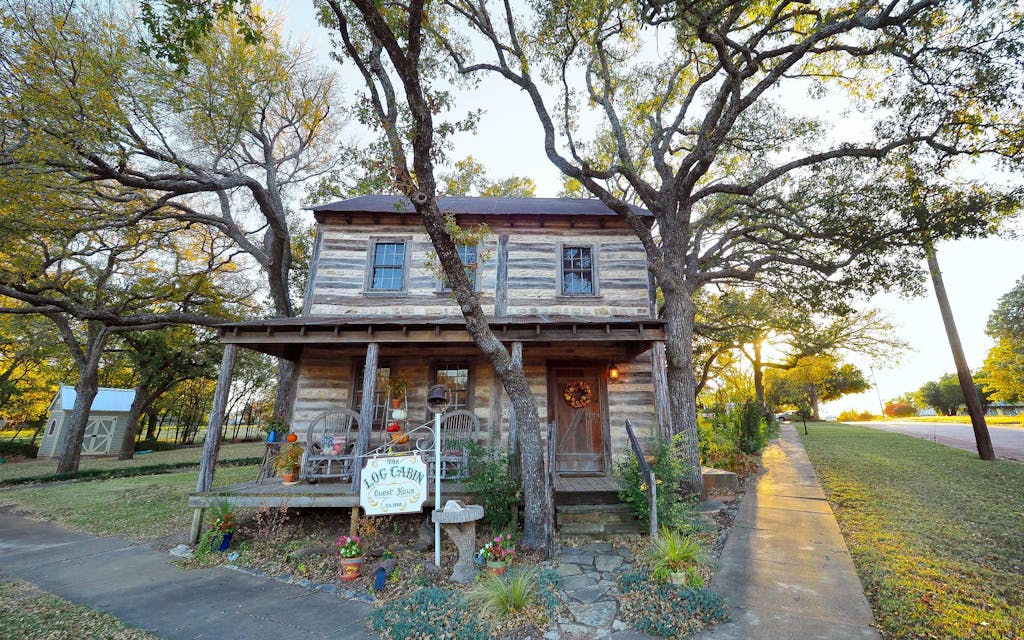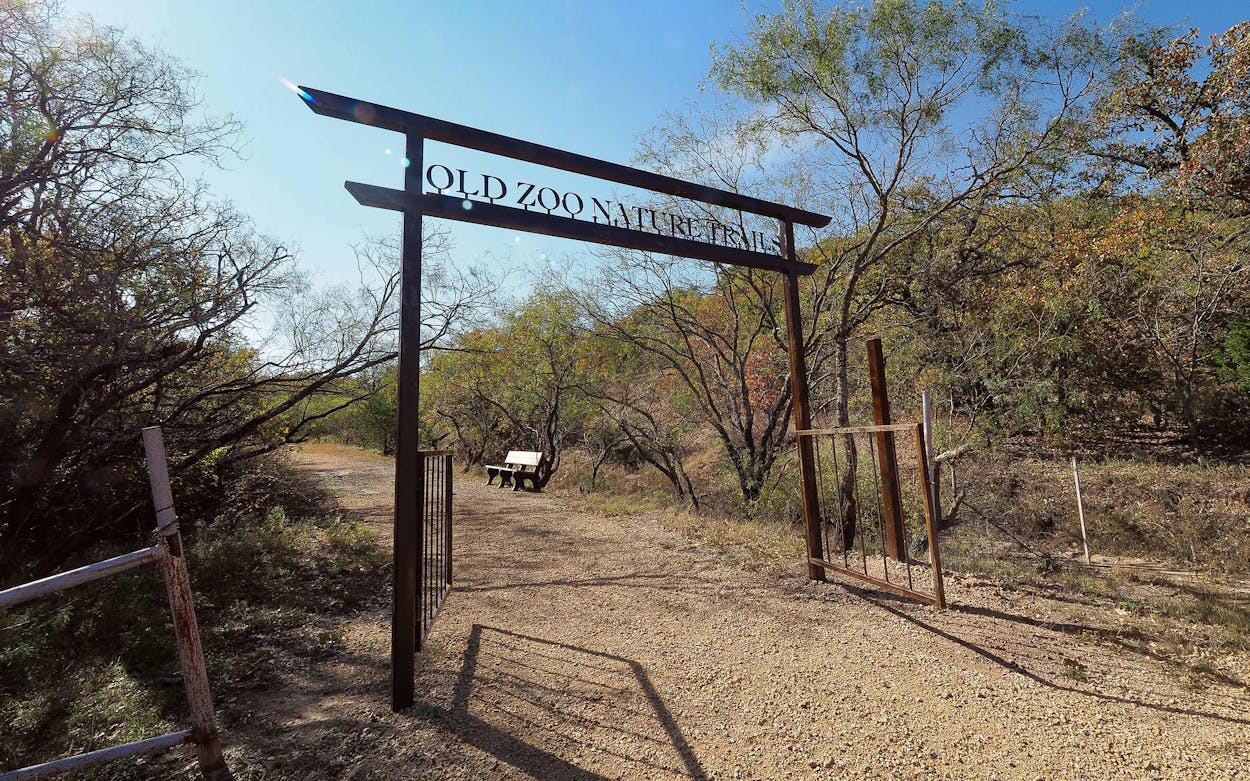When a dam went up on the outskirts of the North Texas town of Cisco during the oil boom in 1923, officials there decided the hulking cement structure could double nicely as a zoo. Someone donated a deer, another contributed a bear, and eventually an assortment of animals moved into damp quarters next to the 96-foot edifice that forms Lake Cisco, which still supplies drinking water for the city.
Apparently, no one thought much about how captive animals might fare in the enclosures at the foot of the buttress-style dam. It didn’t take long to figure out they didn’t like it, and within a year the menagerie was moved to a nearby bluff. Through the twenties and into the thirties, tourists came to see the creatures, to stay in stone cottages, and to swim in the huge man-made pool that opened a few years later below the dam. Unfortunately, this heyday was short-lived. According to yellowed news clippings from the time, the bear was poisoned in an unsolved crime, the deer died, and the zoo eventually lapsed into disrepair.
Although the pool—which its owners once billed as the world’s largest man-made swimming pool—continued to operate into the seventies, brush, vines, and cactus slowly consumed the remains of the zoo. In recent years, people sneaked in to spray graffiti on what remained of the animal dens, and others dumped old mattresses and tires at the site.
Last spring, a nonprofit called Students, Athletics, Families and Education, or SAFE, got permission to clear part of the city-owned property. Volunteers uncovered old pathways and benches, built two hiking paths, and invited the public to take a look. Over the summer, photos of the old ruins began popping up on social media.
The idea of walking the grounds of the old zoo sounded interesting—and deliciously creepy. So, on a cool day in November, I aimed my pickup toward the town, which lies at the intersection of U.S. 183 and Interstate 20, with a mission in mind: I wanted to explore the faded memory of a once-popular tourist attraction.

I booked a room at the Log Cabin Guest Haus, a bed-and-breakfast housed in a log cabin built in the 1840s. Owners John and Mary Kay Williamson bought the house on eBay about fifteen years ago for $6,500, then had it shipped from Pennsylvania to Cisco, where they reassembled it, added two modern bathrooms and a kitchenette, and opened it to visitors. I climbed the creaky wooden stairs to a bedroom, admired the rough-hewn timber walls, tossed down my bags, and set out to learn more about my surroundings.
Cisco got its start as a small frontier community sometime around 1878. First known as Red Gap, the town changed its name a few years later to honor New York financier John A. Cisco. Thanks in part to his efforts, the Houston and Texas Central Railway came to town in 1881, bringing an influx of goods, visitors, and new residents. Today Cisco’s population hovers around 3,800. It’s known as the home of the first Hilton hotel, and retains a certain folksy charm. Some of its streets are paved in red brick, a brewery and two wineries operate downtown, and the whole town rallies behind the high school football team, the Loboes. (“I don’t know why we spell it with an e but we just do,” Mayor Tammy Douglas told me.)
I stopped first at the Lela Latch Lloyd Museum, where I met town historian and Cisco College history teacher Duane Hale. The mundane-looking museum is a treasure trove of oddities inside the original city hall building, which also held a theater.
Hale, who grew up in the area, purchased the building using money that Lloyd, who was a fellow teacher, left him when she died. Old metal detectors hang from one wall; hundreds of branding irons lean against another. You’ll also find the first pair of gloves made at a local factory, a sinister-looking antique dental drill, a school desk from the 1860s, and a 1920s cheerleader megaphone. “A lot of this just comes through the front door,” Hale said, describing how residents often show up with boxes of items to donate. “It’s crazy, isn’t it?”
We squeezed past three church pews temporarily stashed in a hallway, admired a hand-crank washing machine, checked out a vintage shopping cart, and pondered a mysterious stone carving of a head before heading upstairs to see the old auditorium. The theater is abandoned now, but wrestling matches, concerts, and community events all unfolded there. As we poked around, longtime Cisco resident Alice Holliday walked in to say hello. “This is a great auditorium,” she said, reminiscing about the day she sang “Get a Job,” by the Silhouettes, at a talent show held in the theater in the early sixties.
On the way out, we passed a wall devoted to a notorious bit of Cisco history: the Santa Claus bank robbery of 1927. Two days before Christmas, four men, including one dressed as Kris Kringle, held up the First National Bank. A gunfight ensued, three men were killed, and a dramatic manhunt followed. Ultimately, a horde of angry townspeople lynched Santa in retribution for his misdeeds.
The next morning, after the Williamsons had delivered breakfast to the log cabin, I drove downtown to take the town’s pulse. Cisco serves up surprisingly good options for food and drink. During my stay, I tried La Finca for tamales and enchiladas, and the Slowpoke Farm Market for farm-to-table fare including meat loaf, fresh-baked pie, local meats, and cheese. The Red Gap Brewing Company makes its own beer (and root beer), while the Broken X and Blue Duck wineries operate downtown. For a caffeine boost, try Waverly’s, a combination coffee shop, bookshop, and gift store.
My next stop was the Conrad Hilton Center and Museum, where Mayor Douglas was making plans for the upcoming holiday parade. Douglas, 54, does double duty as head of the center and executive director of the Cisco Chamber of Commerce. When I asked her how Conrad Hilton happened to launch his career in such an unlikely location, she smiled.
Hilton operated a bank in New Mexico at the time, she told me, and came to Cisco in 1919, intending to buy another. But he and the bank’s owner couldn’t settle on a price. Frustrated, Hilton decided to get a room at the Mobley Hotel, the two-story red brick building where we now stood. The Mobley, though, was booked. “The owner told [Hilton] it was so busy that he was renting rooms around the clock in eight-hour shifts,” Douglas said.


That perked up Hilton’s ears. He changed his mind and bought the hotel instead of the bank, launching his career in the hospitality business. “He often referred to this hotel as the Great Lady,” Douglas said. He also described it a “cross between a flophouse and a gold mine,” according to a brochure I picked up at the center. You can’t stay the night anymore, but you can drop by to learn a little about Hilton’s history or attend community events.
I wanted to see the old zoo, and Douglas volunteered to take me. “It was awful,” she said of how it looked until recently, recalling all the illegal dumping. She’s proud of the space’s transformation: “It has turned into a really great tourist attraction again.” The place holds special meaning to Douglas, because her father proposed to her mother atop the abandoned monkey cage in the forties.
The Old Zoo Nature Trail starts in a gravel lot just off the highway near Williamson Dam, about four miles north of town. We hiked a quarter of a mile to a spur trail that led up the hillside. Old stone-lined pathways wove among car-size boulders and the rocky outlines of what were once animal dens. Twisted bars from long-gone cages sprouted from one ledge; cacti reached their prickly fingers from what was once a watering trough. I pictured the place ninety years ago, when it was bustling with families who’d come to get a glimpse of the exotic residents.
The zoo wasn’t the only attraction back then. Douglas and I hiked back down, then kept walking toward the huge pool of greenish-blue water below the dam. We could see a bleached wooden frame that once served as a spindly-legged diving platform, and the metal skeleton of a swing set standing ankle-deep in the shallow water. The pool covered an area about the size of two football fields, with a small island in the center. It had concrete walls, but a natural bottom.
The swimming hole closed to the public in the seventies, and the dressing room and adjoining skating rink are long gone. But the bones of the pool, and the memories of the crowds that gathered there, linger. Douglas says she’s dreamed about reopening the pool, and others have intermittently voiced support for the idea. But it would be an expensive project, and one that has no financial backing. For now, the swimmers and the zoo animals exist only in Cisco’s collective memory—and in the imaginations of those who come to wander the trails.
- More About:
- North Texas






